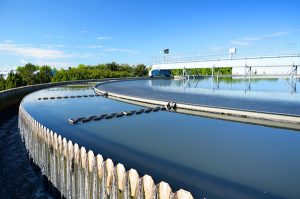Ultraviolet or UV energy is found in the electromagnetic spectrum between visible light and x-rays and can best be described as invisible radiation. In order to kill microorganisms, the UV rays must actually strike the cell. UV, or ultraviolet light, disinfects waste water by damaging the DNA and RNA of microorganisms such as salmonella, giardia, microscopic worms, and viruses. UV treatment does not alter water chemically; nothing is being added except energy.
Municipalities across the country are choosing ultraviolet energy for wastewater disinfection.
Here’s seven reasons behind that:
- UV provides rapid, effective inactivation of microorganisms through a physical process
- It’s simple, safe, and environmentally friendly
- There’s no need to transport, handle, or store toxic or corrosive chemicals
- No disinfection by-products are created and no negative effects on aquatic life
- It’s highly effective at treating chlorine-resistant protozoa such as
- Effective and efficient for all flow rates and is suitable for small rural communities to large municipalities
- Able to treat primary effluent, combined sewer overflow, secondary effluent, and tertiary reuse effluent
The degree of inactivation by ultraviolet radiation is directly related to the UV dose applied to the water. The dosage, a product of UV light intensity and exposure time, is measured in microwatt second per square centimeter (µws/cm2). Most UV units are designed to provide a dosage greater than 30,000 µws/cm2 after one year of continuous operation.
For the UV light to be effective, the UV radiation must come in direct contact with the microorganisms in the wastewater stream. Constituents allow a hiding place for the pathogenic organisms and shield them from the UV light. If the UV light does not come in direct contact with the constituents of concern, then it is useless. Turbidity, suspended solids, and flow rate of the wastewater must be kept at low levels to ensure proper treatment.
Waste water is disinfected when it flows through a chamber that contains many UV lamps. The UV lamps can be arranged horizontally, along the path of the flow, or vertically, perpendicular to the path of the flow. Some systems have two chambers, one after the other, that contain horizontal UV lamps. Other systems feature one long chamber that contains many vertical lamps. The goal is to maximize the amount of UV that reaches the waste water. Both types of UV systems can further be divided into two categories: contact reactors or noncontact reactors. Contact reactors have the UV lamps inside the waste water. Noncontact reactors have UV lamps outside but next to the tube that holds the waste water.
At Universe Optics, we carefully craft precision lenses designed for UV lamps. You can count on our team of engineers, along with our manufacturing team, to ensure the lens meets your specific design.
Not only is ultraviolet energy being used on a large scale, as with wastewater purification, it is trending in homes. With the focus on health, many families today are adding UV systems to their water lines as well. Whether the water comes from a municipal water system, or a private well, a whole house water treatment system can ensure the health of their water supply.
UV purification systems can take water purification to another level and they are a safe solution to remove the dangers of microorganisms from water, whether on the level of a municipality’s water treatment plant, or in the home.
UV Water treatment is:
- Effective – destroying 99.99% of microorganisms
- Chemical Free – UV systems use no chemicals. Water is passed under ultraviolet light to kill organisms
- Environmentally Friendly – UV is a viable, environmentally friendly alternative to chlorination and emits absolutely no by-products
- Trouble Free – once installed, a UV system simply needs annual service
- Reliable – works 24/7/365 keeping your water supply safe
- Safe – no handling of dangerous chemicals is required
- Fast – water flows through the system with no need for a holding tank or reaction times
- Clean – no dirty filters or media to dispose of, ever!
- Low Energy Use
- Conserves Resources – the UV purification process does not waste any water
- FDA Approved – UV is one of only 4 methods approved for disinfection by the FDA
-
Overall, ultraviolet energy for water treatment is an excellent way to purify water. It has been proven to be one of the most reliable, cost-effective ways to disinfect water.